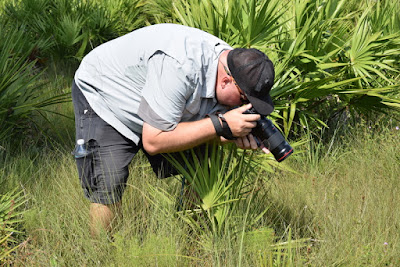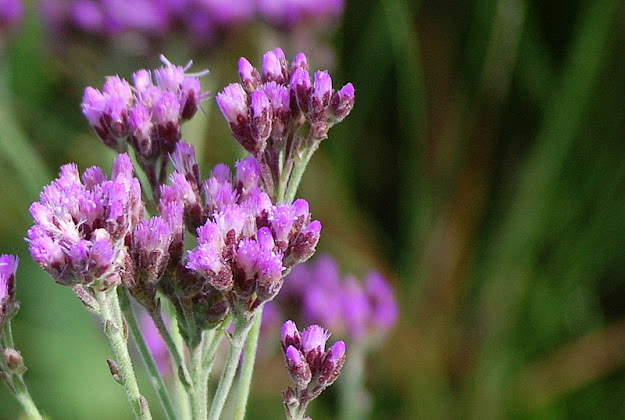Amidst a small convoy of Peace River Butterfly Society members, driving along the Tram Grade, far out into the Babcock/Webb Wildlife Management Area.....I thought to myself, "I don't see any good butterfly habitat"...
Just some mesic prairie and pine flatwoods in the distance. Our outing leader, FGCU botanist, Dr Jay Horn, had scouted the area, but "I don't think there is anything to see here!"
The group scoped the area selected by Jay and with some trepidation waded through the mid calf deep swale to see what there was to see...if anything.
First out was Mike, our newest member and an accomplished photographer with his "big dog" Nikon P900.
WOW! What couldn't be seen from the road was lots of blooming Blazing Star (Liatris spicata) and more than a few nectaring Zebra Swallowtails (Eurytides marcellus).
Look closely, there is lots to see....some butterfly host plants and lots of other interesting flora for botanist Jay to point out.
Here is Quercus minima, a low growing, tiny member of the Oak family!
Quercus minima, the dwarf live oak or minimal oak, is a North American species of shrubs in the beech family. It is native to the southeastern United States. Quercus minima is an evergreen or semi-evergreen shrub rarely more than 2 meters tall, reproducing by seed and also by means of underground rhizomes
Wiikipedia
Fred at the ready with binos and camera...
A nice Black Swallowtail (Papilio polyxenes) also nectaring on Liatris.
Dr Jay pointing out species that would go unnoticed without his knowledge...WOW!
Ph.D., Botany, Duke University, 2005
M.S., Biology, University of North Carolina at Chapel Hill, 1997
B.S., Plant Biology, Cornell University, 1995
Post-doctoral Fellow, Department of Botany, National Museum of Natural History, Smithsonian Institution, 2009–2015
M.S., Biology, University of North Carolina at Chapel Hill, 1997
B.S., Plant Biology, Cornell University, 1995
Post-doctoral Fellow, Department of Botany, National Museum of Natural History, Smithsonian Institution, 2009–2015
Flaxleaf False Foxglove (Agalinis linfolia)
Leslie with iNaturalist phone app and Theresa recording butterfly species.
Cluster-leaf St. Johns Wort (Hypericun cistifolium).
Pineland Rayless Goldenrod (Bigelowia nudata).
Carolina Yellow-eyed Grass (Xyris caroliniana).
Here is a list of the butterfly species seen on this outing...
Zebra Swallowtail (Eurytides marcellus)
Black Swallowtail (Papilio polyxenes)
Barred Yellow (Eurema daira)
Little Yellow (Pyristia lisa)
Gray Hairstreak (Strymon melinus)
Ceraunus Blue (Hemiargus ceraunus)
Little Metalmark (Calephelis virginiensis)
Gulf Fritillary (Agraulis vanillae)
Phaon Crescent (Phyciodes phaon)
Common Buckeye (Junonia coenia)
White Peacock (Anartia jatrophae)
Georgia Satyr (Neonympha areolatus)
Sachem (Atalopedes campestris)
Twin-spot Skipper (Oligoria maculata)
Whirlabout (Polites vibex)
Common Buckeye (Junonia coenia) on
Flat-topped Goldenrod (Euthamia graminifolia).
Captain Josh getting close with his Canon super macro lens
Georgia Satyr (Neonympha aeriolatus).
What's a Satyr?
GREEK MYTHOLOGY
one of a class of lustful, drunken woodland gods. In Greek art they were represented as a man with a horse's ears and tail, but in Roman representations as a man with a goat's ears, tail, legs, and horns.
Grasses! They all look similar to most of us, but they are most important to lepidoptera enthusiasts....as they are host plants for many difficult to identify Skippers! I am hoping Jay will help me to identify this lovely grass!
??????
Whirlabout Skipper (Polites vibex). One of the many Grass Skippers.
When in doubt, assume a good prone position and zero in on target!
What do you suppose Cpt Josh sees?
Gray Hairstreak (Strymon melinus)
Good spot Josh!
A bit late in the season, but here is a Black Swallowtail Instar.
Eveyone gathered to see the highlight of the day!
The Money Shot!
Pine Lilly (Lilium catesbaei)


























































